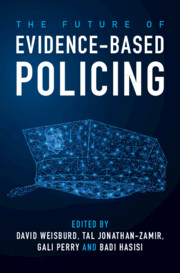Book contents
- The Future of Evidence-Based Policing
- The Future of Evidence-Based Policing
- Copyright page
- Contents
- Figures
- Tables
- Contributors
- Editors
- 1 The Future of Evidence-Based Policing
- Part I Taking Stock of Evidence-Based Policing
- Part II The Evidence for Evidence-Based Policing
- Part III Innovations in Tools of Evaluation and Assessment
- Part IV Challenges to the Implementation of Evidence-Based Policing
- Part V The Practitioner’s Perspective
- 14 The Role of the “Super Evidence Cop” in Evidence-Based Policing
- 15 Looking Back on the Challenges to Evidence-Based Policing
- 16 Support for Evidence-Based Policing at the National Level
- 17 Conclusions
- Index
- References
15 - Looking Back on the Challenges to Evidence-Based Policing
A Chief ’s Perspective
from Part V - The Practitioner’s Perspective
Published online by Cambridge University Press: 01 June 2023
- The Future of Evidence-Based Policing
- The Future of Evidence-Based Policing
- Copyright page
- Contents
- Figures
- Tables
- Contributors
- Editors
- 1 The Future of Evidence-Based Policing
- Part I Taking Stock of Evidence-Based Policing
- Part II The Evidence for Evidence-Based Policing
- Part III Innovations in Tools of Evaluation and Assessment
- Part IV Challenges to the Implementation of Evidence-Based Policing
- Part V The Practitioner’s Perspective
- 14 The Role of the “Super Evidence Cop” in Evidence-Based Policing
- 15 Looking Back on the Challenges to Evidence-Based Policing
- 16 Support for Evidence-Based Policing at the National Level
- 17 Conclusions
- Index
- References
Summary
Over the past two decades, evidence-based policing has become accepted by practitioners around the world. This chapter focuses on evidence-based policing from the perspective of one who has served as a police chief in four different cities, implemented problem-oriented policing in three agencies and engaged in numerous research initiatives with a view toward improving police effectiveness. It discusses the risks and rewards of a police chief conducting research in a real-world laboratory. It provides suggestions on how researchers might encourage broader adoption of evidence-based practices in the future. Finally, the chapter identifies several areas in need of attention by researches in the future.
Keywords
- Type
- Chapter
- Information
- The Future of Evidence-Based Policing , pp. 292 - 314Publisher: Cambridge University PressPrint publication year: 2023
References
- 1
- Cited by

